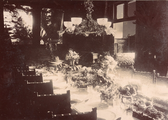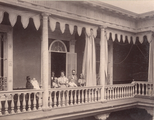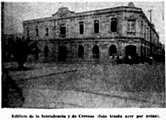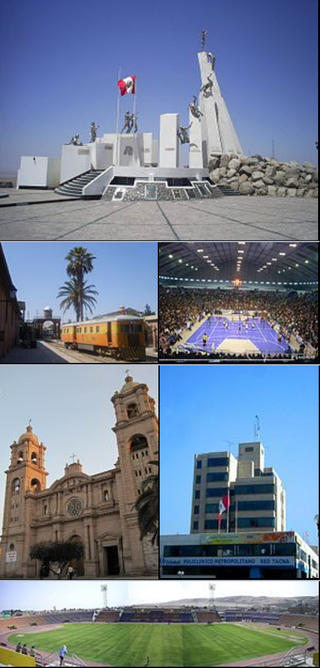
Tacna, officially known as San Pedro de Tacna, is a city in southern Peru and the regional capital of the Tacna Region. A very commercially active city, it is located only 35 km (22 mi) north of the border with Arica y Parinacota Region from Chile, inland from the Pacific Ocean and in the valley of the Caplina River. It is Peru's tenth most populous city.
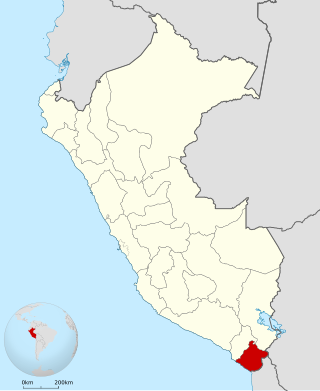
Tacna is the southernmost department and region in Peru. The Chilean Army occupied the present-day Tacna Department during the War of the Pacific from 1885 until 1929 when it was reincorporated into Peru.
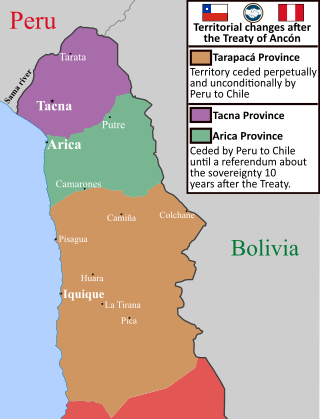
The Treaty of Ancón was a peace treaty signed by Chile and Peru on 20 October 1883, in Ancón, near Lima. It was intended to settle the two nations' remaining territorial differences at the conclusion of their involvement in the War of the Pacific and to stabilise post-bellum relations between them.
Locumba is a town in the Tacna Region in southern Peru. It is the capital of Jorge Basadre Province.

Yonhy Lescano Ancieta is a Peruvian lawyer and politician belonging to the Popular Action party. He was a Congressman between 2001 until the dissolution of the Congress by Martín Vizcarra in 2019. From 2009 to 2011, he served as the Popular Action party's national secretary-general. He was the Popular Action's presidential nominee in the 2021 general election and placed fifth in an atomized race of 18 nominees.

Jorge Alfredo Basadre Grohmann was a Peruvian historian known for his extensive publications about the independent history of his country. He served during two different administrations as Minister of Education and was also director of the Peruvian National Library.

The Tacna Province was a territorial division of Chile that existed between 1884 and 1929. It was ceded by the Treaty of Ancón in 1883 and placed under military administration, and then created on the 31st of October 1884, incorporating the former Peruvian provinces of Tacna and Arica of the also former Tacna Department, as well as a contested claim over Tarata, and was returned to Peru at midnight on the 28th of August 1929, under the terms agreed upon in the Treaty of Lima of the same year.

Vicente Antonio Zeballos Salinas is a Peruvian politician who served as Prime Minister of Peru from September 2019 to July 2020, under President Martín Vizcarra's administration. Prior, he served as Minister of Justice and Human Rights.

The 2020 Peruvian protests were a series of demonstrations sparked after the removal of President Martín Vizcarra that took place from 9 November to 17 November 2020.

Hernando Guerra-García Campos, better known as Nano Guerra, was a Peruvian politician, businessman, and television presenter. He served as a congressman representing Lima for Fuerza Popular from 27 July 2021, until his death in office.

The Tarata Department was a territorial division of Chile that existed between 1911 and 1921. Its territory comprised some controversial territory east of Sama River.

The Hussars of Junín, officially the Cavalry Regiment "Glorious Hussars of Junín" № 1 Liberator of Peru, is a traditional light cavalry regiment of the Peruvian Army. Originally the 4th Squadron of the Peruvian Guard Legion, the unit was renamed in 1824 to its current name after its performance in the Battle of Junín.

The Chilean–Peruvian territorial dispute is a territorial dispute between Chile and Peru that started in the aftermath of the War of the Pacific and ended significantly in 1929 with the signing of the Treaty of Lima and in 2014 with a ruling by the International Court of Justice. The dispute applies since 2014 to a 37,610 km2 territory in the Chile–Peru border, as a result of the maritime dispute between both states.

The 2022–2023 Apurímac protests corresponds to a series of protests and violent confrontations that began on 10 December 2022 in the department of Apurímac in the context of the December 2022 Peruvian protests. The protesters demand the resignation of President Dina Boluarte, the closure of the Congress of the Republic, and new general elections. Unlike the protests in other regions and cities, in Apurímac the confrontations are more violent, and criminal acts have been recorded, such as the kidnapping of police officers and attacks on police stations. The Boluarte government declared a state of emergency, removing some constitutional protections from citizens, including the rights preventing troops from staying within private homes and buildings, freedom of movement, freedom of assembly and "personal freedom and security".

The Giacoletti Building, also known as the Juan Romano Building, was a historical commercial building located in San Martín Plaza. In 1972 it was declared a historical monument of Lima. The building was destroyed in a fire on October 27, 2018.

The Bridge of Sighs is a wooden pedestrian overpass located between the Hermitage of Barranco and Zepita passage in Barranco District, in Lima, Peru. It is one of the most visited tourist places in the historic district, and a meeting point for couples in love.
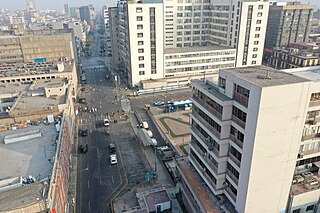
Mesa Redonda is a shopping centre in the neighbourhood of Barrios Altos, part of the historic centre of Lima, Peru. The area is surrounded by Huanta and Cuzco streets, as well as Abancay and Nicolás de Piérola avenues. Known for its informality, its the site of a number of fires, notably that of 2001.
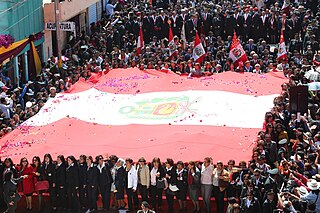
The Flag procession is a civic-military ceremony held annually in the Peruvian city of Tacna on August 28 with the purpose of commemorating the date on which Tacna Province rejoined Peru after the period of Chilean occupation that lasted from 1880 until 1929, when the Treaty of Lima was signed, as a consequence of the War of the Pacific.

San Ramón Church was a 19th-century Catholic church located in Tacna which played an important role during the War of the Pacific and the subsequent Chilean administration of the city. The entire complex housed the church and a hospital of the same name built in 1848, which was also used as a psychiatric centre and a women's prison over time. The church was closed in 1909 by the Chilean mayor Máximo Lira, and was later destroyed. Currently the land belongs to the Charity of Tacna and was declared Cultural Heritage of the Nation in 2005, with its reconstruction announced but not yet started.
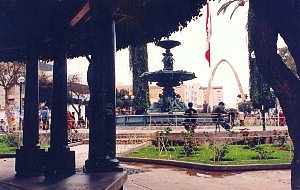
San Martín Avenue is the main thoroughfare of the historic centre of Tacna, Peru. It houses landmarks such as the Cathedral, the Parabolic Arch, the Ornamental Fountain, the home of Jorge Basadre and the former Municipal Palace. When it reaches the cathedral, it splits into two avenues: Blondell and Callao. South of the cathedral is the city's main square, which it surrounds.



